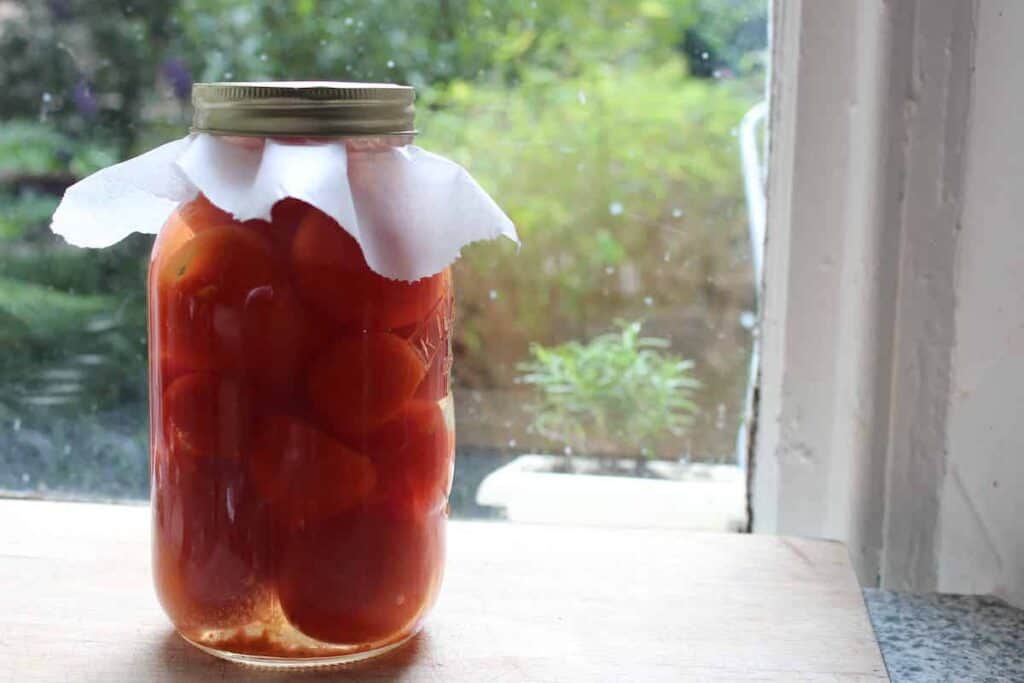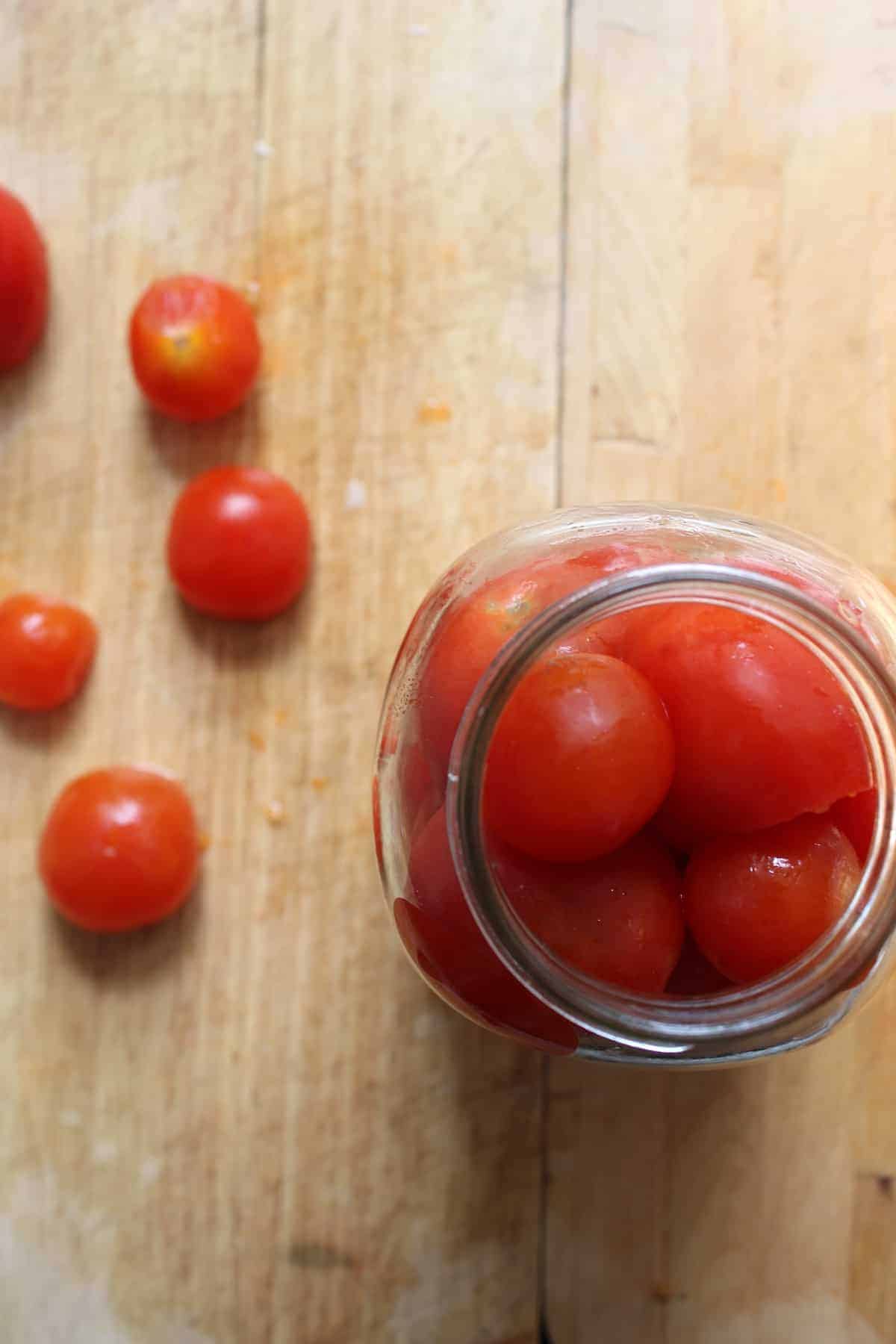Last Updated on June 1, 2025 by Nico
Fermented tomatoes take only minutes to make and are a great way to consume more gut-healthy probiotics. With only a couple of ingredients, you’ll be enjoying fresh summery flavors all year round. Plus, fermentation is an easy preservation method that enhances the health benefits of tomatoes.

Fermenting veggies – tomatoes, cabbage, garlic, onions, and more – is a great way to preserve fresh summer foods for enjoying in the cooler months. And it’s a simple and fast way to consume more gut-healthy probiotics. Probiotics help to heal the lining of our gut, which then can help to boost your immune system, improve mental clarity, and support good gut health. Lacto-fermentation is a traditional process that enhances beneficial bacteria and preserves the fresh ingredients naturally.
(For other ideas to boost your probiotics, try making bone broth from chicken feet or kefir smoothies!)
All you need to ferment veggies is salt, filtered water, and glass jars. The process takes only a few minutes to complete, making it an easy recipe to incorporate into your kitchen routine.
You might think you need to harvest your own veggies from a backyard garden to get started with fermenting, but that’s not the case. My family and I live in a small urban apartment with minimal outdoor space. I buy my veggies from the grocery store and farmer’s market and just ferment those. Whether you use grape tomatoes, larger tomatoes, or fresh cherry tomatoes, this method works well.
Watch The Video
How to make fermented tomatoes
Ingredients
- Unadulterated sea salt – such as pink Himalayan sea salt (here’s a bulk source)
- Tomatoes (grape tomatoes, cherry tomatoes, or other small tomatoes work best)
- Filtered water
- Optional – fresh herbs (such as fresh basil or coriander seed)
For complete measurements, see the printable recipe card below.
Supplies
- Glass mason jars (wide-mouth jars are best)
- Fermenting weight (pickle pebbles or a glass fermentation weight work well)
- Saucepan
- Spoon
- Jar lid

Instructions
Add water and sea salt to your saucepan and heat until salt is dissolved. Set aside to cool.
Wash your tomatoes thoroughly.
Pack your glass jar as full as you can without crushing the tomatoes. It’s best to leave the tomatoes whole.

If using fresh herbs, add basil, mustard seeds, or garlic cloves into the jar with the tomatoes for extra flavor.
Once the saltwater brine has cooled, pour it over the tomatoes, and make sure that they are fully covered in the brine.
Set a fermenting weight on top of the tomatoes to keep them below the brine. I use a pickle pebble but you can simply use a rock in a ziplock bag!
Add a loose lid or fermentation lid to the top of the jar. Put the jar on a plate or towel to catch any overflow and leave it sit in a room temperature place. I like to simply leave mine on our kitchen countertop!
How long the fermentation process will take depends on the temperature in your home. A small batch in half-gallon mason jars can be ready in 6-8 days, while a gallon jar may take 3-4 weeks. You will know fermentation is happening when bubbles form in the salt brine, and it becomes foggy due to carbon dioxide release and lactic acid formation.
After the tomatoes are fermented (this will either take a week or a month depending on the size of your jar), move the fermented tomatoes to cold storage, such as the fridge or a cool, dark place, to slow down further fermentation.
What are the benefits of lacto-fermented tomatoes?
The lacto-fermentation process facilitates the growth of beneficial bacteria. Consuming fermented foods, such as fermented cherry tomatoes, sauerkraut, and kefir, supports gut health, the immune system, and overall digestion. This method also preserves the tomatoes’ nutrients and enhances their tanginess!
How to use fermented tomatoes
In sandwiches – Layer them with cheese and fresh ingredients for a delicious fermented tomato sandwich.
Pizza or pasta sauce – Blend the tomatoes and add garlic, onion, and herbs to make a fermented tomato sauce.
Raw – Add the tomatoes to salads or as a side dish.
Expert tips
Use a glass jar to ferment vegetables and avoid metal or plastic.
Always use unadulterated salt, like sea salt, and avoid iodized salt.
What do fermented tomatoes taste like?
They have a tangy tomato taste. You can add herbs like fresh basil for a more blended flavor.
How long do fermented tomatoes last?
They should last up to 12 months in cold storage.
How to know if the tomatoes are fermented?
You will see bubbles form in the brine and the brine will become cloudy. If it’s becoming too sour, move them to the fridge.
How to store fermented tomatoes?
Store them in the fridge, a cellar, or another dark place to slow fermentation. Avoid direct sunlight to maintain a stable fermentation process.
Save it for later

What to read next
Two-Ingredient Simple Garlic Fermented Honey
Strawberry Kefir Smoothie Recipe
Simple Lacto-Fermented Carrots
If you make this recipe and enjoy it, please consider giving it 5 stars. Find me on Instagram @documentingsimpleliving and show me what you’ve made!

Simple Fermented Tomatoes
Ingredients
Equipment
Method
- Add water and sea salt to your saucepan and heat until salt is dissolved. Set aside to cool.
- Wash your tomatoes thoroughly.
- Pack your glass jar as full as you can without crushing the tomatoes. It’s best to leave the tomatoes whole.
- If using fresh herbs, add basil, mustard seeds, or garlic cloves into the jar with the tomatoes for extra flavor.
- Once the saltwater brine has cooled, pour it over the tomatoes, and make sure that they are fully covered in the brine.
- Set a fermenting weight on top of the tomatoes to keep them below the brine. I use a pickle pebble but you can simply use a rock in a ziplock bag!
- Add a loose lid or fermentation lid to the top of the jar. Put the jar on a plate or towel to catch any overflow and leave it sit in a room temperature place. I like to simply leave mine on our kitchen countertop!
- How long the fermentation process will take depends on the temperature in your home. A small batch in half-gallon mason jars can be ready in 6-8 days, while a gallon jar may take 3-4 weeks. You will know fermentation is happening when bubbles form in the salt brine, and it becomes foggy due to carbon dioxide release and lactic acid formation.
- After the tomatoes are fermented (this will either take a week or a month depending on the size of your jar), move the fermented tomatoes to cold storage, such as the fridge or a cool, dark place, to slow down further fermentation.
I ferment cherry tomatoes grown in garden. They are delicious. I now prick the toms before I put into jar. It prevents pressure building up in the tomato & juice squirting off plate when you cut into them.
That’s a great idea. Pricking them would also be a simple way to prevent them from becoming too squishy while fermenting
Normally the brine, or level of salt used in fermenting is expressed as a percentage of total weight of the item being fermented and any water added. I normally use 3% for peppers and such. Have done lots of peppers and hot sauces.
I think I am going to stick with 3% as my target and give the tomatoes a shot. Thanks for the information!!
They sound like they will be utterly delicious.
That’s a great tip – thank you! Your fermented hot sauces sound delicious
I fermented them in a large jar. I want to move them to smaller jars now. Do I keep them covered in the brine? Or do I add other liquid?
Keep them covered in the brine.
Thanks so much for this, tomatoes are my very favorite food. I’m new to fermenting, I’ve made sauerkraut and now I’m doing tomatoes. I can’t wait to try them!
Great to hear 🙂